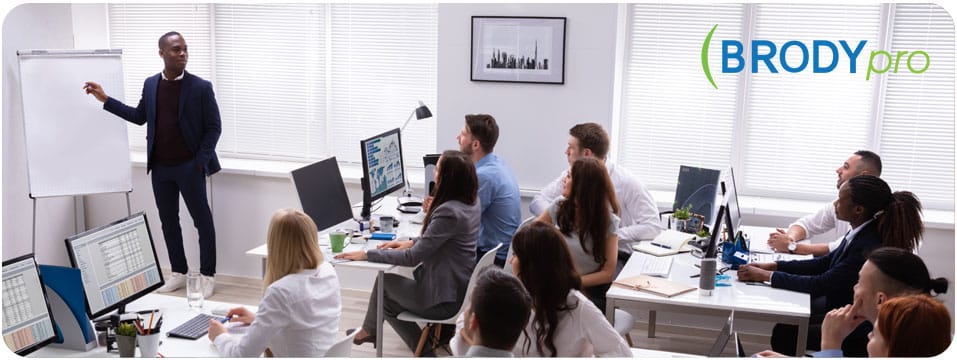Presentations are a crucial part of business, whether it’s to pitch new clients, communicate with C-level executives, or inspire employees to align with a new vision.
Effective presentation skills can have a serious impact on your company’s bottom line. Since not everyone is born an amazing communicator, presentation skills workshops are one way to enable your employees to develop this critical skill.
Businesses around the world have invested in presentation skills workshops to support their overall success. If you’ve never participated in one of these workshops, you might be wondering what to expect. Below is an overview of what a great presentation skills workshop could look like.
Overcoming Nerves
Employees are often nervous about going to a presentation skills workshop, because they know it will involve presenting in front of a group. An experienced facilitator will help ease the tension in a variety of ways such as:
- Setting expectations for a safe and supportive learning environment
- Starting with low-risk activities like paired exercises
- Providing strategies that can be applied immediately to improve presentations
- Engaging learners in the benefits of participation in the workshop
While participants may begin with some apprehension, they appreciate what they are able to gain from the workshop, which will increase their ability to:
- Deliver presentations with confidence and poise
- Design their message in a clear and compelling way
- Capture their audience’s attention from the first word
- Answer questions with succinct, well-formulated responses
How Do Workshops Improve Presentation Skills?
How can someone go into a workshop in the morning a terrible presenter and come out in the afternoon a good presenter?
A great presentation skills workshop will follow a proven method for developing presentation skills. Here are some of the workshop components that BRODY uses:
- Baseline Presentation. Recording a baseline presentation enables participants to see where they are now, and what they need to improve. Watching themselves on video raises their self-awareness and guides the facilitator on areas of focus.
- Platform Skills. After viewing their recording, the workshop facilitator dives into delivery skills. Also known as delivery dynamics, your platform skills encompass your visual, vocal and verbal expression. We’ve all heard the expression, “It’s not just what you say, it’s how you say it!” Platform skills focus on what you say and how you say it. This includes:
- Visual signals: Posture, movement, gestures, eye contact, and facial expressions
- Vocal signals: Pitch, speed, volume and fillers
- Verbal signals: Word choice, power robbers, and industry jargon
- Organizing a Presentation. Without a strong organization, any presentation will fall flat. The audience may become confused, distracted, and disengaged. A great presentation skills workshop will provide a step-by-step process for organizing your information, including your:
- Purpose, Audience, and Logistics (PAL™)
- Powerful opening
- Main topics to be covered
- Supporting information (not just facts and figures)
- Transitions between topics
- Memorable closing
- Participant Presentations. Once participants understand how to organize their presentation and deliver it effectively, they have an opportunity to put everything they learned into practice. During an extended lunch, they prepare their presentation, and then each person presents. These presentations are recorded, so participants can see the improvement they’ve made in just a few short hours! The key to this part is creating a safe learning environment where participants can try out new skills without fear of making mistakes. Coaching and feedback are delivered in a supportive and encouraging manner.
- A well-known adage is “practice makes perfect,” but only if you’re practicing the right way. A great presentation skills coach will reinforce strengths and identify specific areas for improvement moving forward.
Workshop Logistics
Ideally, a presentation skills workshop should be a full day in length. Shorter workshops will cut into your time on either learning new skills or practicing them. You can shorten the workshop if you have fewer participants. For example, a session with the maximum of 10 participants will take a full day, but with 5 participants, you could shave off a couple hours from the practice time.
Selecting a Workshop
Now that we have seen what goes into a presentation skills workshop and what you can expect, how do you select a great presentation skills workshop?
With so many options available in the marketplace, it can be difficult to understand what sets apart one provider from another.
Our advice is to find a provider with an experienced team that is also familiar with your industry. Your provider should spend time up front understanding your business, the roles of the people attending, their specific presentation skills challenges, and how they will be applying the skills they learned.
When you invest in a presentation skills workshop for your team, you want to ensure that the end result translates to tangible business goals. That means the session will be tailored so that it meets your specific objectives.
Are their presentations formal or informal? Seated or standing? Ten minutes or an hour? Delivered to senior leaders or individual contributors? Are your presenters in sales, marketing, IT, operations, or leadership? What are they looking to accomplish through their presentations?
A provider that asks questions to truly understand your needs should be able to tailor a presentation skills workshop that is right for your team.
If you’d like to learn more about BRODY presentation skills workshops or if you’d like to discuss the specifics of your own situation in more detail, please contact us. We have been in business for more than 35 years and have a team of expert facilitators capable of understanding the unique needs of your team.
